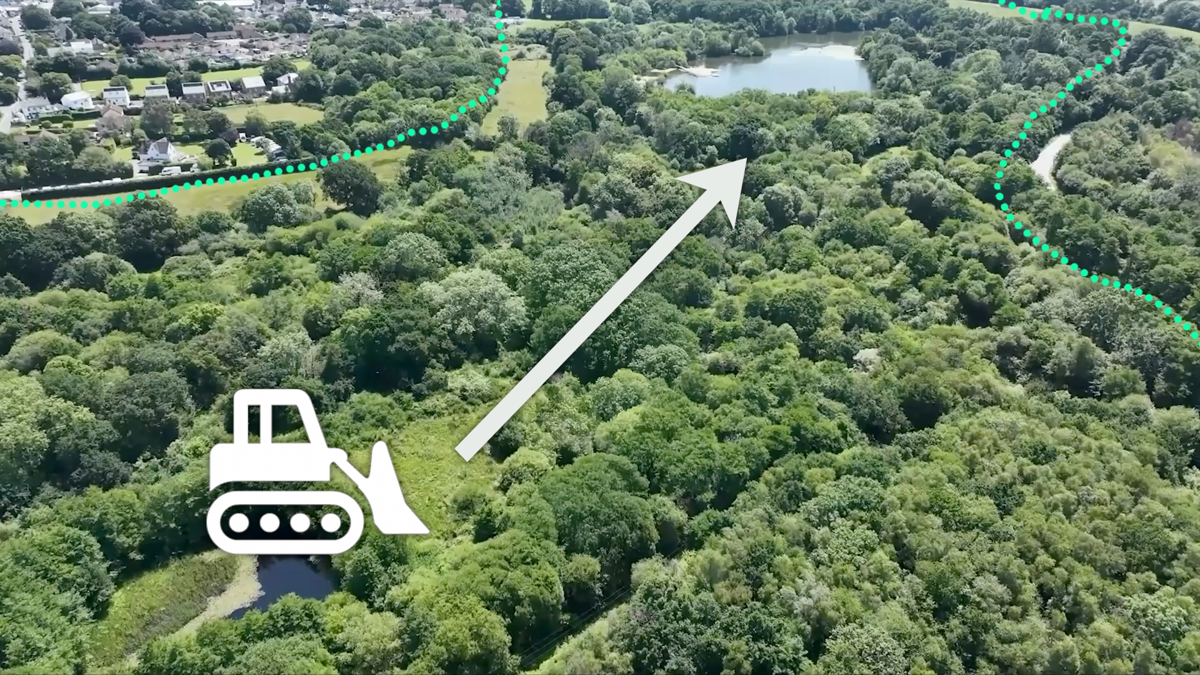
The Hidden Danger of Quarry Dust
Invisible. Unmonitored. Potentially deadly.
The health threat no one sees coming
Silica dust — known technically as Respirable Crystalline Silica (RCS) — is among the most dangerous pollutants produced by UK quarrying. These microscopic particles, less than 10 microns in diameter, travel easily on the wind. Once inhaled, they lodge deep within the lungs where the body cannot remove them, causing cumulative, irreversible damage over time.
RCS is officially recognised as a Group 1 human carcinogen by the International Agency for Research on Cancer and confirmed by the UK Health and Safety Executive to cause silicosis, chronic obstructive pulmonary disease (COPD), and lung cancer.
Invisible RCS particles can have cumulative effects and cause long term lung disease
A legacy of bad science and weak policy
For decades, dust monitoring in Bovey Basin quarries has focused on coarse, visible particles, not the fine airborne fraction (sized < PM₁₀) that also causes disease [11]
The Institute of Air Quality Management (IAQM) requires that PM₁₀ impacts be assessed wherever sensitive receptors (e.g. people or homes) exist within 1 km of a mineral site — and notes that most health impacts occur between 250 m and 400 m, while finer particles can persist far beyond that distance.
The Scottish Government’s PAN 50 guidance reaches the same conclusion: residents near mineral sites can be affected by site dust up to one kilometre from the source.
Despite this, the UK still has no statutory limit for quarry dust nuisance, leaving communities unprotected even when World Health Organisation air-quality standards are exceeded.
Local evidence: white dust, real lives
Residents living near Kingsteignton’s clay works routinely find white film deposits on cars and windows. Independent experts identify these residues as silica-bearing clay dust.
One former WBB Minerals estates manager objected to the company’s earlier New Cross plans, warning that “proximity to clay-dust sources” posed a major health risk. Others have since been diagnosed with pleural plaques — a lung-scarring condition linked to long-term silica exposure.
Children and the elderly face the greatest risk. Fine particulates aggravate asthma, impair lung growth, and increase heart-disease mortality.
Policy and legal framework
The proposed Zitherixon quarry sits alarmingly close to dense residential areas:
-
Hundreds of homes within 100 – 400 m
-
An elderly care home within 200 m
-
A primary school at 400 m, and two more schools within 600–700m

Under Devon Minerals Plan Policy M6, ball-clay developments must “minimise and mitigate dust impacts on community frontages and protect sensitive receptors.”
Given these distances and the 50-year lifespan proposed, that standard cannot be met.
The scheme also breaches Teignbridge Local Plan Policies EN2A and EN12, which require the protection of woodland buffers and prevention of amenity loss. Removing the existing tree belt would eliminate the only natural dust barrier for Kingsteignton’s residents.
Dust from industrial premises that is “prejudicial to health or a nuisance” is defined as a statutory nuisance under the Environmental Protection Act 1990 s.79–80, enforceable by abatement notice.
In addition, both the Health and Safety at Work Act 1974 s.3 and the Control of Substances Hazardous to Health Regulations 2002 (COSHH) oblige operators to prevent risk to non-employees — including neighbours — from hazardous dust emissions.
Finally, national policy is clear: the National Planning Policy Framework (Dec 2024) directs decision-makers to “prevent new development from contributing to unacceptable levels of air pollution and to protect public health.”
No safe distance, no safe level
Ball clay itself contains quartz; when dry, extraction and haulage inevitably create respirable crystalline silica.
The IAQM and PAN 50 confirm that dust of this size cannot be contained within the boundary of a working quarry, particularly during dry, windy weather or high vehicle movement.
Over a 50-year operating horizon, even minor lapses — failed water sprays, uncovered loads, or simple track-out onto local roads — will expose surrounding homes, schools, and care facilities to cumulative dust plumes.
Continuous suppression and real-time monitoring would require perfect compliance for four decades, something no operator can guarantee. Where residual risk remains significant, the law requires refusal.
It is scandalous that Sibelco have been getting away with monitoring only the larger visible particles. and not the smaller airborne ones
Save Our Trees CampaignThe only lawful and moral outcome: full refusal
There is no realistic mitigation that can make the Zitherixon quarry safe.
Monitoring is reactive; once the dust escapes, it cannot be undone.
Given the number of vulnerable receptors — families, schoolchildren, elderly residents — this proposal cannot be made acceptable by conditions or management plans.
Under the Devon Minerals Plan, Teignbridge Local Plan, the Environmental Protection Act, and the NPPF, the only compliant decision is full refusal.
Approval would knowingly expose the public to a proven carcinogen and breach the council’s statutory duty of care.
It’s illegal for Sibelo to knowingly release RCS into our community. The roads are already coated in white silica dust from the quarries, and this demonstrates that there’s zero chance people won’t be exposed to this carcinogen over the next 50 years.
Save Our Trees CampaignKey references
-
[1] Devon Minerals Plan Policy M6 (Ball Clay in the Bovey Basin) – Devon County Council
-
[2] Teignbridge Local Plan Policies EN2A and EN12 – Teignbridge District Council
-
[3] Environmental Protection Act 1990 s.79–80 – legislation.gov.uk
-
[4] Health and Safety at Work etc. Act 1974 s.3 – legislation.gov.uk
-
[5] HSE Silica Dust Guidance (INDG463) – hse.gov.uk/pubns/indg463.htm
-
[6] IAQM Guidance on the Assessment of Mineral Dust Impacts (2016) – iaqm.co.uk
-
[7] Scottish Government PAN 50 Annex B – gov.scot
-
[8] British Geological Survey Ball Clay Factsheet – nora.nerc.ac.uk
-
[9] IARC Monograph on Crystalline Silica – publications.iarc.who.int
-
[10] NPPF (Dec 2024) – gov.uk/government/publications/national-planning-policy-framework
-
[11] Environmental Dust Impact Assessment, Bovey Basin (2007) – Southacre Quarry ROMP
Keep up to date with our latest news from our campaign to protect our community and our environment.











